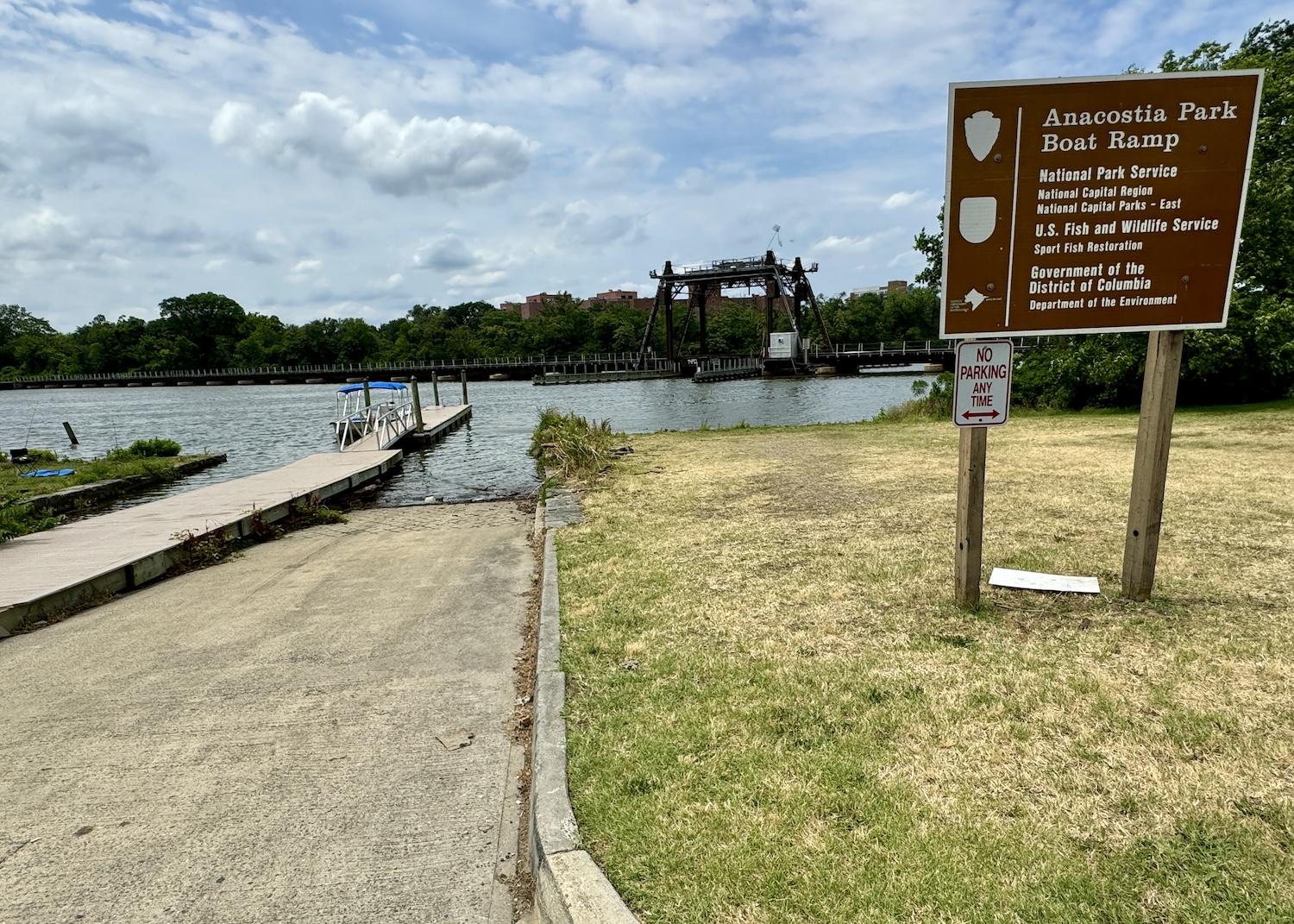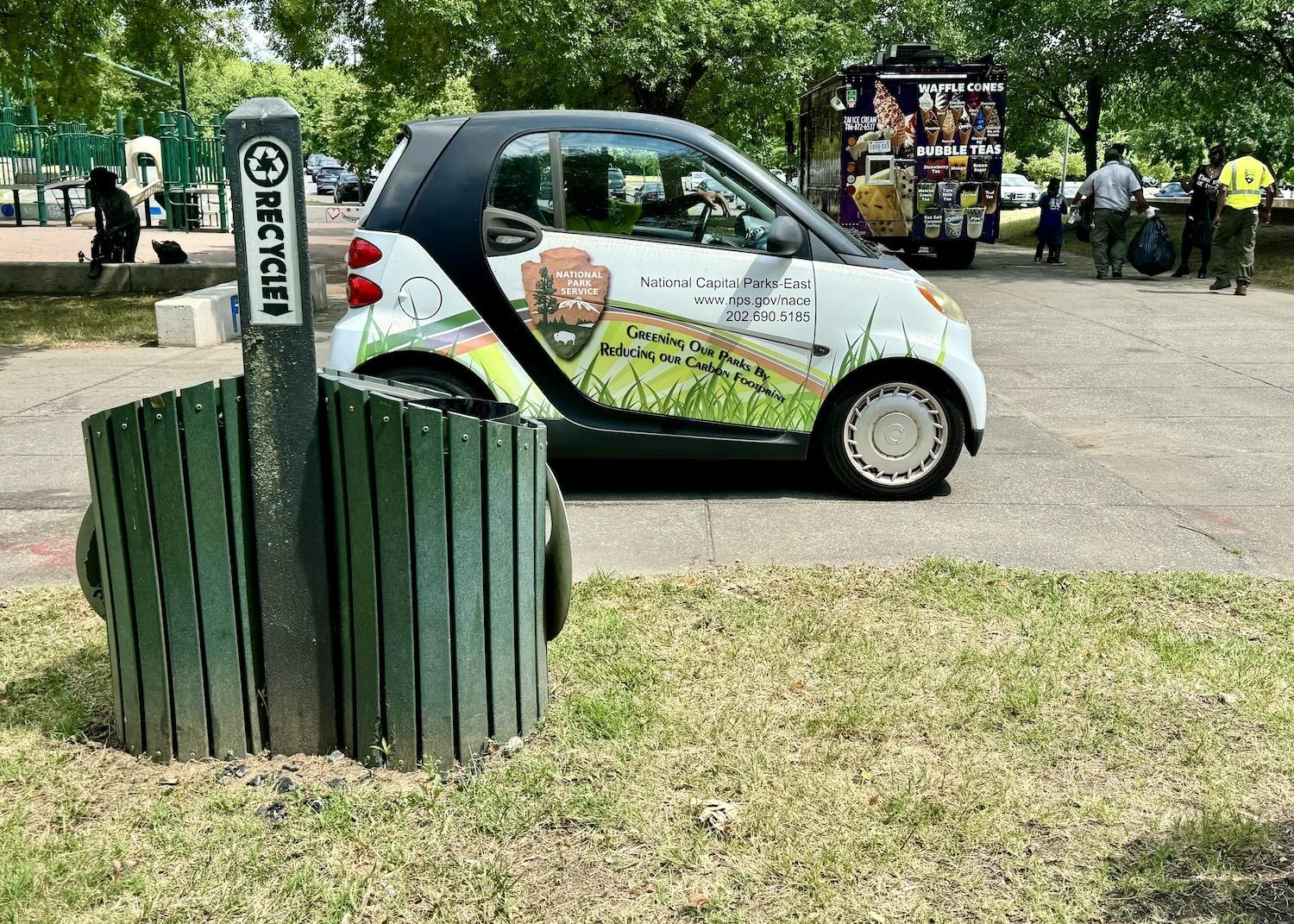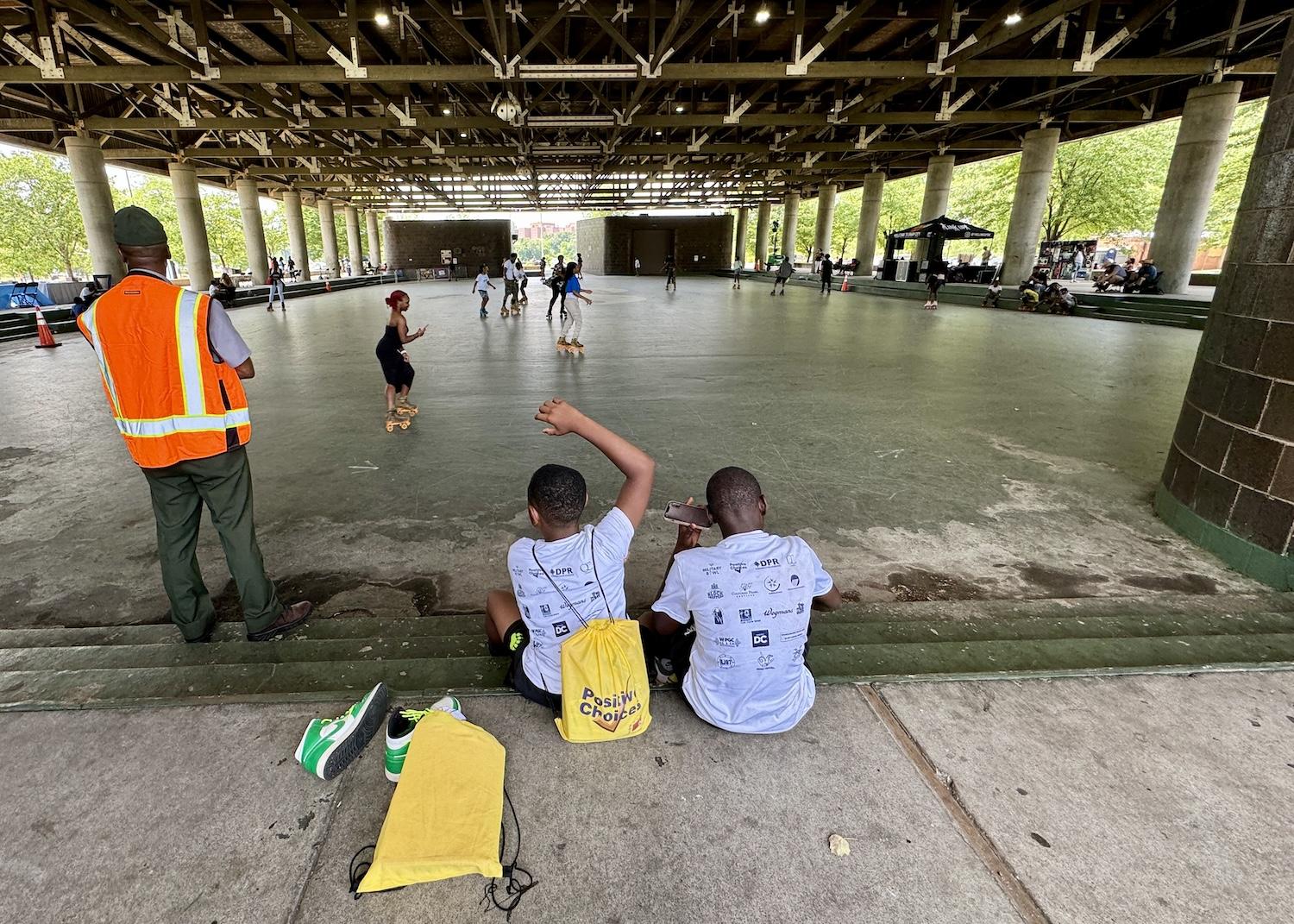In the only U.S. national park with a roller-skating pavilion, Akiima Price strolls around the monthly Late Skate event making sure the community is happy. DJs provide the soundtrack as young skaters wobble in between adults with serious skills. Extended families watch from the sidelines. Vendors sell bubble tea and volunteers dole out apples and oranges. As always, skate rentals are free.
Those who haven’t laced up are either having lawn chair picnics in the parking lot or hanging out by the pretty but polluted Anacostia River for catch-and-release fishing and pontoon boat trips.
What sets Anacostia Park apart from most NPS units is not just the roller skating, but the people who love and use the 1,108-acre green space in Washington, D.C.. “I would venture to say this is the most African American-used park in the National Park Service,” says Price, the founder and interim executive director of the Friends of Anacostia Park.

Akiima Price is the founder of the Friends of Anacostia Park Society/Jennifer Bain
For more than a century, this urban park has been the “literal and figurative backyard” for neighborhoods east of the Anacostia River that have endured decades of disinvestment and institutional neglect. “Uplifting Anacostia Park means uplifting the residents that frequent the park,” the Friends group likes to say.
Price has reimagined the non-profit program from a trauma-based lens to empower residents to serve as stewards of their green space and enjoy meaningful programs and events that support mental, physical and social wellness.
The skate culture thrives thanks to free equipment rentals and regular events. The fishing culture dates back to the Indigenous people who lived here before colonization. Elders meet for hand dancing, a regional form of swing dancing from the 1950s and D.C.'s official dance. Birders, joggers, walkers and cyclists enjoy the park’s Anacostia Riverwalk Trail sections.

You can't swim or eat fish from the Anacostia River, but you can use the NPS boat lamp to explore the freshwater tidal river by kayak or boat/Jennifer Bain
Created for locals, not out-of-towners, this is a safe place to seek refuge from lives marked by poverty, obesity, diabetes, crime and racism.
It’s no surprise, though, that roller skating is a bigger draw than the riverfront. “The water is polluted,” laments Price, “so it’s not advised to eat the fish or swim.”
The park, which sprawls in a thin strip along both sides of the freshwater tidal river, is hard for a first-timer to grasp. I don’t visit the Capitol Hill side, just the section separated from the southside Anacostia community by a freeway. When Uber drops me at the so-called park entrance, it’s an empty intersection beside a pirate ship playground. I’m not sure I’m in the right place until I spot a NPS sign for the skating pavilion.

NPS vehicles zip around Anacostia Park during a Late Skate event/Jennifer Bain
Named and established by a 1918 act of Congress, Anacostia Park was turned over to the NPS in 1933 under the Capper-Cramton Act. So was Kenilworth Park & Aquatic Gardens in 1938. Both share a superintendent and are managed by National Capital Parks-East, and Kenilworth is within Anacostia. “Historically, the park has not been managed as a unified public asset, and as a result, areas of the park have been underused and under programmed,” admits the shared Foundation Document Overview.
That much is obvious. After checking out Kenilworth's water lilies and lotus blossoms (five miles away), I focus my visit to Anacostia Park proper on just a smidgeon of its space — a boat ramp and the aging roller-skating pavilion.
For Late Skate events, which run the last Saturday of the month from June to October, the Anacostia Watershed Society provides free boat tours. Usually they pass under an old railroad bridge and visit a wild area along the river where Price says “you can really forget you’re in an urban area.”

Anacostia Watershed Society's Austin DeOrio takes a pontoon boat down the Anacostia River during Late Skate events at Anacostia Park/Jennifer Bain
Today, though, there’s an event up that way so Austin DeOrio heads the other direction past the more affluent Washington Navy Yard neighborhood to the Frederick Douglass Memorial Bridge. Pointing out things like an Osprey nest and Cormorants, DeOrio shares stories about the society’s work to make the river fishable and swimmable. I make a note to visit Frederick Douglass National HIstoric Site and learn about the abolitionist who was born enslaved.
Back on shore, we hear that someone has landed a seven-pound catfish.
I connect with Bruce Holmes, who was born and raised in what’s now Historic Anacostia — one street away from the Frederick Douglass property — and runs the park’s fishing programs.

Bruce Holmes has been using Anacostia Park his whole life and now, through the Friends of Anacostia Park, teaches community and Junior Ranger Angler programs/Jennifer Bain
“Where I fish at, I would love to see us have some bleachers down there that could probably sit 25 or 30 people — and put a top over it,” he says wistfully. “What we would sell would be not so much the fishing, but the water. From the mental aspect, you can just sit in the bleachers. Because you’re not going to see that water when you go back home.”
Holmes grew up in this park, although as a kid he swam in the then-segregated pool under the watchful eyes of lifeguards while his family prepared picnics outside. It wasn’t until he was about 10 or 12 that he started “fishing” (technically scooping up nets full of herring). Now 65, he learned to fish in Texas before returning home, meeting Price, mentioning he loved fishing and agreeing to learn to teach it.
“You’re going to relax at this park,” Holmes promises. “There is peace at this park. And so by god if we’re going to market the fish, then make it fishable and comfortable enough that people will say `I’ll meet you at the fishing dock.’”

On a Saturday in June, people set up lawn chairs and picnics in the parking lot at Anacostia Park near the roller-skating pavilion/Jennifer Bain
Holmes would like to see the park do a better job of encouraging people to visit Kenilworth “to get nature” and then come here “to get recreation.” He wants people to come “for information by way of recreation” and it upsets him that there isn’t a visitor center.
Well at least there’s a NPS park brochure map that highlights a complex history that began with the Nacotchtanks and continued with European explorers like John Smith. There was tobacco farming that used enslaved labor, 1949 race riots surrounding the segregated swimming pool, and white flight to the suburbs. There were once power plants along the river and open trash burning in a dump that covered the community with smoke until the 1960s. Homes and community centers were demolished for the highway.
Nowadays, Holmes loves teaching the Junior Ranger Angler program and telling kids they must have patience to fish. He clearly has that virtue himself, because when I ask him about NPS work to reimagine Anacostia, he says “we’ve been reimagining that for 10 years.”

It's free to visit Anacostia Park and free to borrow roller skates/Jennifer Bain
The park has two projects on the go — a development concept plan to improve the area between the 11th Street Bridge and south of the CSX tracks (just past the skating pavilion), and deferred maintenance and repair work.
The NPS has about $2 million to design and implement recommendations of the Anacostia Park Development Concept Plan for two sections of the park. Three design concepts are currently open for public comment. Highlights include better transportation access, shaded picnic areas, increased water access, a tree-lined promenade and enhanced recreational facilities.
From my home in Canada, I watched a virtual public meeting in June and the biggest takeaway is that Anacostians are crazy for pickleball — the world's fastest-growing sport — and lobbying for dedicated courts. When pressed for a project timeline, the NPS tells me that some proposed actions will need further environmental and historical reviews, and implementation will depend on funding.

NPS rangers Stephanie Weinstein and Joe Cashman chat with a community member at the Late Skate event about plans to reimagine Anacostia Park/Jennifer Bain
The other project is in its design phase, and construction is expected to run from late 2025 through 2027. Thanks to an unspecified amount from the Great American Outdoors Act Legacy Restoration Fund, the skating pavilion, restrooms, basketball and tennis courts, playgrounds and picnic areas are slated for rehabilitation.
As Holmes and I watch park rangers set up a booth at Late Skate to share the concept plans, I encourage him to put his dreams for riverside fishing bleachers in writing once again on a comment card. While Holmes knows the park is lucky to have a river and a roller-skating pavilion, he confides that he hasn’t put on skates for 45 years (except briefly for a TV news story).
To find out more about the now iconic pavilion, I turn to a 2021 report I find online that's called “Anacostia Park: Cultural Landscapes Inventory, National Capital Parks-East.”

Unveiled in 1976, the modernist roller skating pavilion at Anacostia Park is showing its age/Jennifer Bain
The “Bicentennial Pavilion” was unveiled in 1976 during U.S. bicentennial celebrations. Designed by the modernist firm Keyes, Lethbridge & Condon, the flexible and open-air space now known as the Anacostia Park Skating Pavilion features a large open area and curved terracotta-block offices and storage rooms under its roof.
With large wooden trusses resting on reinforced concrete pillars, the pavilion reminded lead architect Colden Florance of a “classical Washington temple in a green setting.” That's admittedly a little hard to picture.
Florance also lovingly described the pavilion as a “giant jukebox playing music to skate by.” Here we are nearly half a century later and while DJs are handling the music now (spinning songs like "wwhy MME" by Mdhg Skittzo), the people are still skating.

There is funding to do some rehabilitation of the Anacostia Park Skating Pavilion/Jennifer Bain







